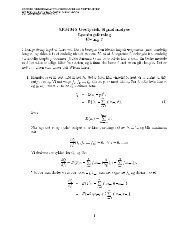Slug Catchers in Natural Gas Production - NTNU
Slug Catchers in Natural Gas Production - NTNU
Slug Catchers in Natural Gas Production - NTNU
Create successful ePaper yourself
Turn your PDF publications into a flip-book with our unique Google optimized e-Paper software.
Karam – <strong>Slug</strong> <strong>Catchers</strong> <strong>in</strong> <strong>Natural</strong> <strong>Gas</strong> <strong>Production</strong><br />
3.1 <strong>Slug</strong> Catcher types<br />
CHAPTER 3 SLUG CATCHERS<br />
A slug catcher, which is a part of the gas pipel<strong>in</strong>e system, is an essential equipment at the receiv<strong>in</strong>g<br />
term<strong>in</strong>al of a multiphase flow process<strong>in</strong>g plant. The specific function of a slug catcher is the separation<br />
of the gas and liquid phases as well as the storage of the liquids temporarily. The gas is then sent for<br />
further treatment <strong>in</strong> the gas-treat<strong>in</strong>g facilities downstream the pipes. The slug catcher is ma<strong>in</strong>ly made<br />
up of two different compartments: the first one <strong>in</strong>cludes the gas-liquid separator under steady flow<br />
conditions while the second consists of the storage where the received liquid is accumulated under<br />
operat<strong>in</strong>g conditions. The gas will be guaranteed to reach the downstream facilities as the accumulated<br />
liquid will displace the exist<strong>in</strong>g gas <strong>in</strong> a relatively cont<strong>in</strong>uous pattern. The size of the slug catcher<br />
should be determ<strong>in</strong>ed by the size of the largest slug that is possible to form <strong>in</strong> the pipel<strong>in</strong>e.<br />
The appropriate design of the slug catcher accounts largely to avoid problems at the receiv<strong>in</strong>g<br />
term<strong>in</strong>als. In order to prevent the acceleration of the gas/liquid mixture, the <strong>in</strong>let diameter of the pipes<br />
enter<strong>in</strong>g the slug catcher should be the same as that of the pipel<strong>in</strong>e. Normally the slug catcher is made<br />
up of a series of pipes that are parallel and <strong>in</strong>cl<strong>in</strong>ed <strong>in</strong> order to give the hold-up volume for the liquid<br />
(Shell, 1998). Each one of these pipes <strong>in</strong> the slug catcher is known as a f<strong>in</strong>ger. The upper end of the<br />
pipes discharges the gas while the bottom end discharges the liquid. A strong structure and foundation<br />
ma<strong>in</strong>ta<strong>in</strong> the pipes so as to support the impact of the slug.<br />
The slug catchers exist <strong>in</strong> three different types: the vessel type, the multi-pipe type and the park<strong>in</strong>g<br />
loop type. The vessel type can range from a simple to a more complicated knock-out vessel which is<br />
ma<strong>in</strong>ly used for limited plot sizes such as offshore platforms due to its small size. For large volumes of<br />
slugs which implies a volume exceed<strong>in</strong>g 100 m 3 , the multi-pipe or park<strong>in</strong>g loop slug catchers are<br />
ma<strong>in</strong>ly used. The multi-pipe slug catcher is made up of a liquid and gas separation entry slot and a<br />
series of parallel tilted bottles where the liquid is stored. The <strong>in</strong>flow of liquid gets first through the<br />
splitter <strong>in</strong>to the <strong>in</strong>let manifold and then down to the bottles mov<strong>in</strong>g thus the exist<strong>in</strong>g gas up to the gas<br />
outlet risers. As a consequence, a cont<strong>in</strong>uous gas flow is ma<strong>in</strong>ta<strong>in</strong>ed to the downstream facilities.<br />
Therefore, the advantage of this slug catcher category is the ease of operation due to a free flow<br />
Page 8 of 56

















